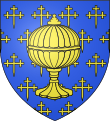Alfonso VII of León and Castile
This article needs additional citations for verification. (September 2013) |
| Alfonso VII | |
|---|---|
Cathedral of Toledo | |
| Spouses | |
| Issue among others... |
|
Raymond, Count of Galicia | |
| Mother | Urraca of León and Castile |
Alfonso VII (1 March 1105
Alfonso was a dignified and somewhat enigmatic figure. His rule was characterised by the renewed supremacy of the western kingdoms of Christian
Succession to three kingdoms
In 1111,
When Alfonso the Battler,
In several skirmishes, he defeated the joint Navarro-Aragonese army and put the kingdoms to vassalage. He had the strong support of the lords north of the
Imperial rule

A vague tradition had always assigned the title of emperor to the sovereign who held León.
On 26 May 1135, Alfonso was crowned "Emperor of Spain" in the
War against Al-Andalus
Alfonso was a pious prince. He introduced the
… early in the morning the castle was surrendered and the towers were filled with Christian knights, and the royal standards were raised above a high tower. Those who held the standards shouted out loud and proclaimed "Long live Alfonso, emperor of León and Toledo!"
In 1142, Alfonso
Legacy
Alfonso was at once a patron of the church and a protector, though not a supporter of, the Muslims, who were a minority of his subjects. His reign ended in an unsuccessful campaign against the rising power of the Almohads. Though he was not actually defeated, his death in the pass, while on his way back to Toledo, occurred in circumstances which showed that no man could be what he claimed to be – "king of the men of the two religions." Furthermore, by dividing his realm between his sons, he ensured that Christendom would not present the new Almohad threat with a united front.
Family
In November 1128, he married
She died in 1149. Their children were:- Ramón, living 1136, died in childhood[14]
- Sancho III of Castile (1134–1158)[15]
- Ferdinand II of León (1137–1188)[15]
- Constance (c. 1138–1160), married Louis VII of France[16]
- Sancha (c. 1139–1179), married Sancho VI of Navarre[17]
- García (c. 1142–1145/6)
- Alfonso (1144/1148–c. 1149)
In 1152, Alfonso married
- Ferdinand (1153–1157)[19]
- Alfonso II of Aragón.
Alfonso also had two mistresses, having children by both. By an
Family tree
In fiction
A parody version of king Alfonso and queen Berengaria is presented in the tragicomedy La venganza de Don Mendo by Pedro Muñoz Seca. In its film version, Antonio Garisa played Alfonso.[21]
References
- ^ a b c d Reilly 2003, p. 59.
- ^ a b Fletcher 1984, p. 133.
- ^ Stroll 2004, p. 239.
- ^ Reilly 1998, p. 12.
- ^ Waag 2022, p. 83.
- ^ France 2005, p. 122.
- ^ a b Lourie 1975, p. 635.
- ^ a b c d Reilly 2003, p. 60.
- ^ Reilly 1998, p. 309.
- ^ Powers 2010, p. 432.
- ^ Riley-Smith 1990, p. 48.
- ^ Barton 1997, p. 286.
- ^ Graham-Leigh 2005, p. table 4.
- ^ Reilly 1998, pp. 27–28.
- ^ a b Barton 1997, p. 13.
- ^ Hanley 2019, p. 233.
- ^ Bryson 1999, p. 29.
- ^ Reilly 1998, p. 114.
- ^ Reilly 1998, p. 307.
- ^ Reilly 1998, p. 143.
- ISBN 978-84-96613-10-2. Retrieved 31 December 2020.
Bibliography
- Barton, Simon (1997). The Aristocracy in Twelfth-century León and Castile. Cambridge: Cambridge University Press. ISBN 9780521497275.
- Bryson, David (1999). Queen Jeanne and the Promised Land: Dynasty, Homeland, Religion and Violence in Sixteenth-Century France. Brill.
- Fletcher, R.A. (1984). Saint James's catapult : the life and times of Diego Gelmírez of Santiago de Compostela. Oxford [Oxfordshire]: Clarendon Press. ISBN 978-0198225812.
- France, John (2005). The Crusades and the Expansion of Catholic Christendom, 1000–1714. Routledge.
- Graham-Leigh, Elaine (2005). The Southern French Nobility and the Albigensian Crusade. The Boydell Press.
- Hanley, Catherine (2019). Matilda: Empress, Queen, Warrior. Yale University Press.
- Lourie, Elena (1975). "The Will of Alfonso I, "El Batallador," King of Aragon and Navarre: A Reassessment". Speculum. 50 (4 Oct): 635–651. S2CID 159659007.
- Reilly, Bernard F. (2003). "Alfonso VII, King of León and Castile". In E. Michael Gerli (ed.). Medieval Iberia: An encyclopedia. Taylor & Francis. pp. 59–60. OCLC 701323223.
- Reilly, Bernard F. (1998). The Kingdom of León-Castilla Under King Alfonso VII, 1126–1157. Philadelphia: University of Pennsylvania Press. ISBN 9780812234527.
- Riley-Smith, Jonathan (1990). Atlas of the Crusades. New York: Facts on File. ISBN 9780816021864.
- Powers, James F. (2010). "Coria, Siege of". In Rogers, Clifford J. (ed.). The Oxford Encyclopedia of Medieval Warfare and Military Technology. Vol. 1. Oxford University Press.
- Stroll, Mary (2004). Calixtus II, 1119–1124. Leiden; Boston: Brill. ISBN 9789004139879.
- Waag, Anaïs (2022). "Rulership, Authority, and Power in the Middle Ages: The Porprietary Queen as Head of Dynasty". Anglo-Norman Studies XLIV. Boydell & Brewer. pp. 71–104. ISBN 9781800106314.
External links
- Arnaldo, Bishop of Astorga, wrote an account of Alfonso VII's life and reign known as the Chronica Adefonsi Imperatoris.



